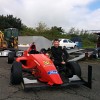horse wrote:miqi23 wrote:cars at half car length behind the lead car lose around 55% of their down-force
Well, I guess this is also what makes a "tow" effective. Losing the downforce is also reducing the drag penalty, which is beneficial in a straight line.
miqi23 wrote:cars at half car length behind the lead car [have] a 10% balance shift to the rear
The mechanics of this relate to the method by which downforce is generated. The rear and centre downforce generation comes from the floor and rear wing whereas the front downforce is solely the responsibility of the front wing. As the floor is less effected by the turbulent length scales within the wake of the forward car it continues to work better than the smaller aerodynamic surfaces. Thus the contribution from the diffuser will shift the balance rearward.
Yes, but the loss in drag is not 55% behind the lead car at half car length, it is around 30% - however, it is still good enough for slip streaming. That loss translates to an efficiency reduction of around 20% behind the lead car at half car length.
If we look at the mechanics of down-force reduction in a bit more detail, at half car length the front wing of a following car generally loses around 45% of its down-force, the rear wing around 42% and the underfloor around 48%. The balance shift to the rear is a result of not just the front wing losing its down-force but a combination of the three major down-force producing components.
..and from a down-force contribution point of view the floor produces around 55% of the total down-force, the front wing around 30% and the rear wing around 25%. Losing 48% of the total 55% floor down-force is still a massive loss and it is not an even loss, it is at the floor inlet which is driven by the barge-boards vortices and other interacting flow structures which has lost most of its energy by being in a wake of another car.

